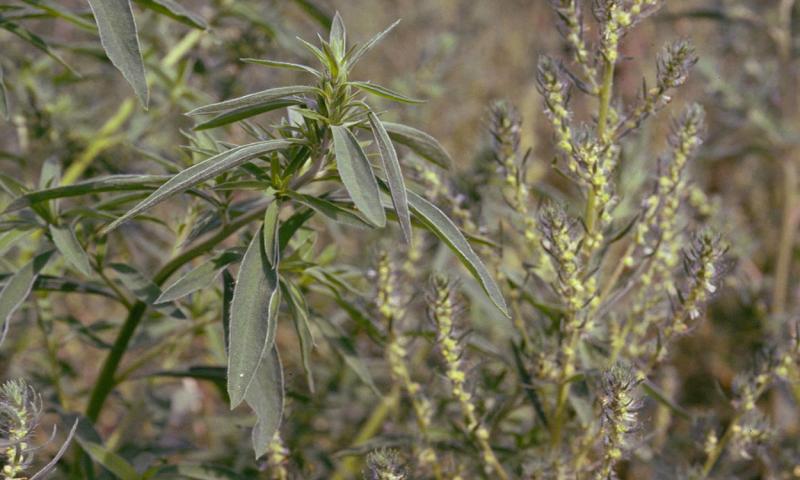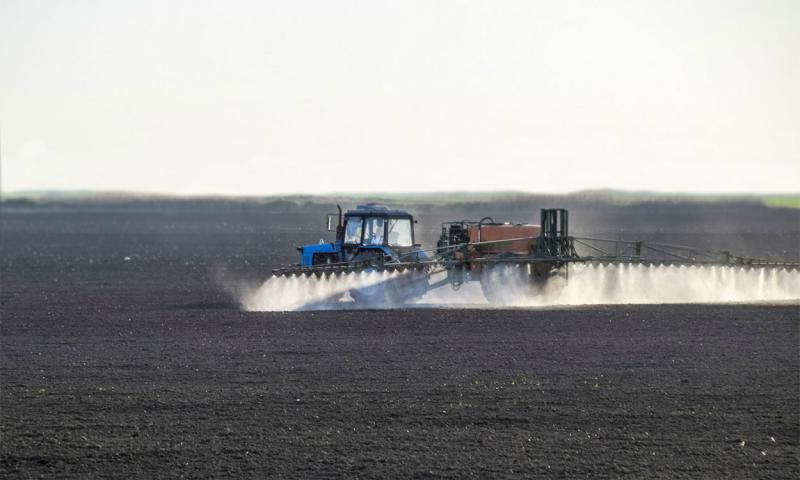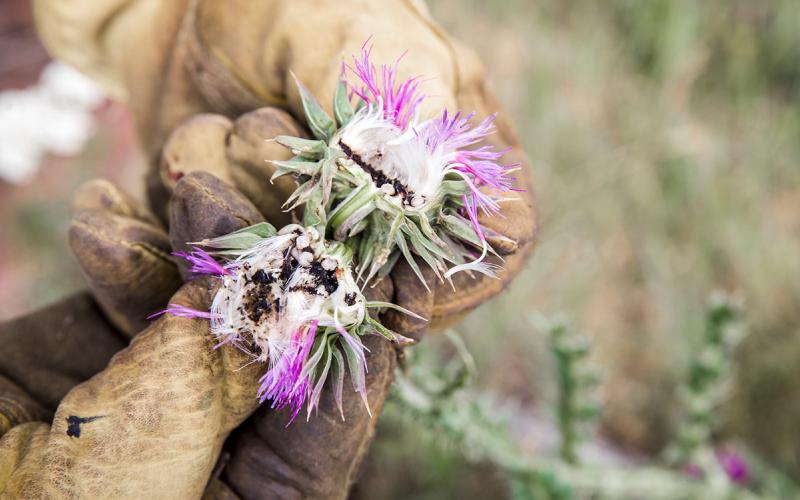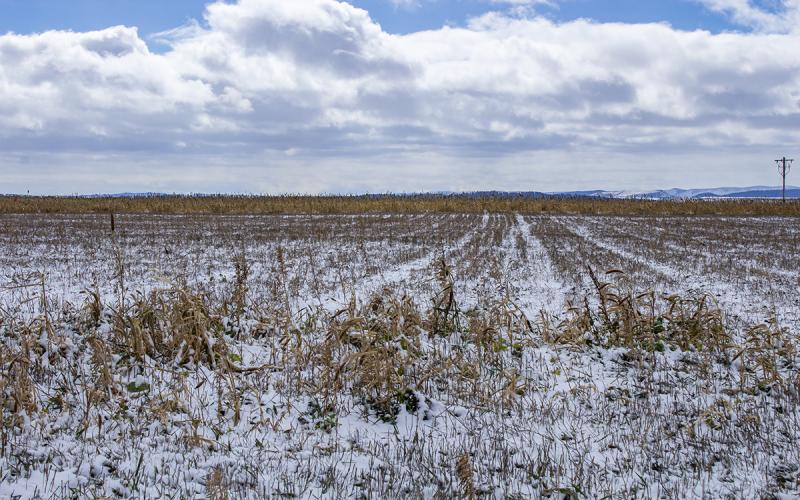
Written collaboratively by Eric Jones, Philip Rozeboom, David Vos, and Jill Alms.
Kochia is a weed that is found in most crops throughout South Dakota. If kochia is not effectively controlled, crop yield can be reduced significantly. Control complexity of kochia is due to the biology of the plant and herbicide resistance. Globally, kochia is resistant to ALS-inhibiting herbicides (such as imazethapyr [Pursuit] and thifensulfuron [Harmony]), synthetic auxin herbicides (such as dicamba [Banvel, Clarity, others] and fluoxypyr [Starane, others]), PSII-inhibiting herbicides (such as atrazine), glyphosate (such as Roundup), and PPO-inhibiting herbicides (such as carfentrazone [Aim] and saflufenacil [Sharpen]). Currently in South Dakota, kochia populations have documented resistance to ALS-inhibiting herbicides and glyphosate.
Kochia can germinate under cooler temperatures early in the season. If early germinating kochia cannot be controlled with tillage due to production practices, then a burndown herbicide application should be made prior to crop planting. Dicamba (Banvel, Clarity, others) and saflufenacil (Sharpen) are commonly applied burndown herbicides in South Dakota to control kochia. However, caution should be made before applying these herbicides this season. Several kochia populations in North Dakota and Saskatchewan have recently been confirmed to be carfentrazone-and-saflufenacil-resistant due to overreliance on these herbicides. Additionally, dicamba-resistant kochia has been confirmed in states and Canadian provinces near South Dakota.
Management Tactics
Chemical Control

Preplant burndown herbicides should be applied under relatively high-light conditions and when temperatures are at least 55 degrees Fahrenheit. Applying burndown herbicides under overcast and low temperature conditions can result in control reductions on all weeds.
While control failures with dicamba or saflufenacil have not been reported in South Dakota, proactive decisions should be made to extend the effectiveness of these herbicides. Adding different herbicide groups to the tank for the burndown application can reduce selection pressure on resistant weeds and increase the control spectrum for other weed species. Applying different PPO-inhibiting herbicides (including tiafenacil [Reviton] and pyraflufen [Vida]) will not reduce selection pressure on resistant weeds. If applying dicamba or a similar synthetic auxin herbicide (including halauxifen methyl [Elevore]), refer to the label to determine if there are any planting interval restrictions to a specific crop. Refer to herbicide labels to determine if herbicides can be tank-mixed before purchasing and applying products.
Paraquat (Graxomone and others) is a viable option for preplant burndown. Kochia plants should be less than 4 inches in height at the time of application. Paraquat has no soil residual activity; consider adding a preemergence herbicide to the tank mix or applying the preemergence herbicide at the time of crop planting. Some herbicides, such as atrazine and metribuzin (Sencor, Tricor, other), can increase paraquat activity and provide residual control when tank mixed. Refer to the atrazine and metribuzin labels to determine if these herbicides are safe for the crop to be planted.
Glufosinate (Liberty) should not be used as a burndown herbicide. Glufosinate requires high heat, humidity, and light to effectively control weeds; these environmental variables can be limited in the early season. Additionally, glufosinate should be saved for in-season postemergence applications to control later-emerging kochia and other weeds. While glufosinate is effective on kochia and other weeds, this herbicide needs to be stewarded correctly to ensure there is minimal selection pressure on resistant biotypes.
While glyphosate-resistant kochia is common in South Dakota, the herbicide still has utility in controlling other weeds present (including prickly lettuce and dandelion). Scout fields prior to application to determine if select fields have weeds that can effectively be controlled with glyphosate.
Preemergence herbicides should be utilized even if a burndown herbicide application is made. If the burndown herbicide is tank-mixed with a herbicide with residual activity, use an herbicide from a different group. Preemergence kochia control when planted into soybean or sunflower can be achieved with sulfentrazone (Spartan, Authority products, others); again, do not rely solely on one herbicide. The HPPD-inhibiting herbicides (including mesotrione [Callisto, component of Acuron, and others], isoxaflutole [Balance]) will control kochia when applied preemergence in a corn crop. However, these herbicides mixed with atrazine will likely improve kochia and other weed control.
Additionally, there are more-effective herbicide options to control kochia in grass crops compared to broadleaf crops. Fields that are heavily infested with kochia could be planted with grass crops for more effective herbicides. Again, herbicides should be applied in tank mixes, and other non-chemical management tactics should be utilized where feasible.
A comprehensive list of herbicides labeled for kochia control in South Dakota crops can be found in the latest South Dakota Pest Management Guides.
Cultural Control
Crop rotation can influence kochia control. Winter wheat can suppress early germinating kochia. Other grass crops (including corn, sorghum, and spring wheat) can suppress kochia with canopy closure if the early germinating plants are effectively controlled. Broadleaf crops (soybean and sunflower) may not provide as much suppression due to later canopy closure. Broadleaf crops can be planted in narrow row spacing to increase the time to canopy closure for increased suppression.
Mechanical Control
Kochia surviving burndown applications should be removed to ensure that any offspring possessing any potential herbicide resistance traits does not enter the soil seedbank. Removal can be accomplished with hand weeding smaller, isolated areas or with mowing on larger areas prior to crop planting. Strategic, prescription-deep tillage can be implemented to control emerged kochia plants and bury seeds deeper into the soil profile to inhibit germination. Shallow tillage can stimulate kochia germination. This tactic can be strategically implemented prior to a pre- and/or postemergence herbicide application to increase control by depleting the soil seedbank.
In Summary
Kochia should be managed with an integrated approach utilizing chemical, cultural, and mechanical tactics. While herbicides are likely the most-effective and efficient tactic to control kochia (and other weeds), recurrent and intensive use will eventually select for resistant plants. Utilizing integrated tactics can reduce selection pressure on resistant plants and improve weed management. If kochia control failures occur, be sure to report the incident to SDSU Extension personnel so further testing can be conducted.


